Biology topic 3-Infection and response
1/69
There's no tags or description
Looks like no tags are added yet.
Name | Mastery | Learn | Test | Matching | Spaced |
|---|
No study sessions yet.
70 Terms
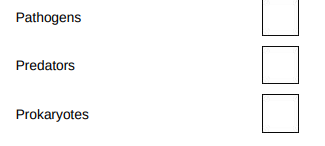
What name is given to microorganisms that cause disease?(1)
Pathogens
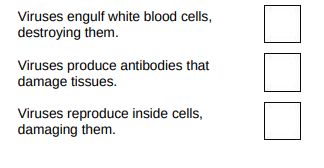
How do viruses cause the symptoms of disease?(1)
Viruses reproduce inside cells, damaging them
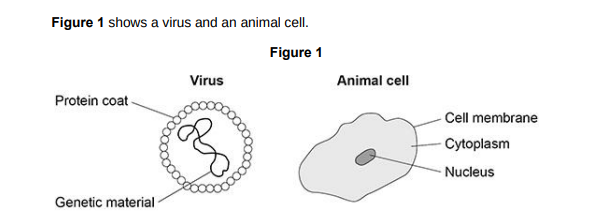
Suggest one reason why viruses are not classed as cells.(1)
They do not have a cytoplasm
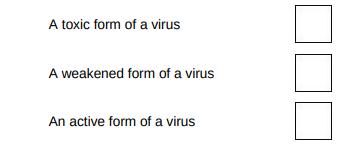
A vaccine can protect humans from a viral disease.(1)
A weakened form of a virus
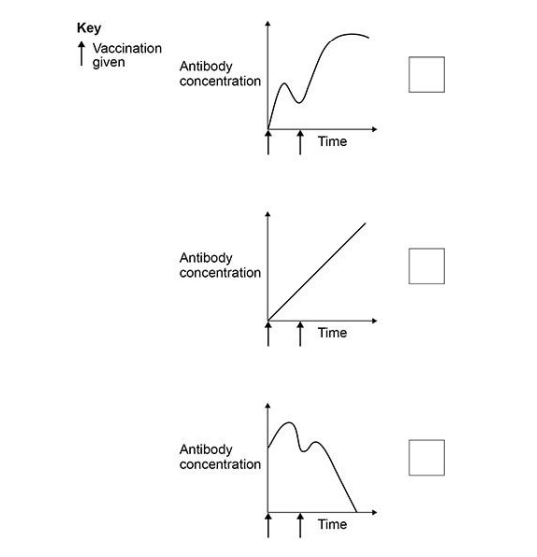
In some cases, a first vaccination needs to be followed by a second vaccination sometime later. Which graph shows how the concentration of antibodies in a person’s blood changes after the first and second vaccinations? (1)
1
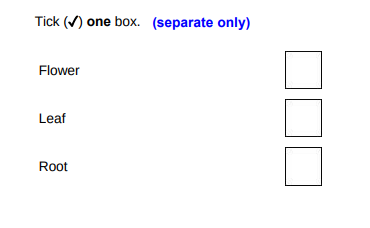
Which part of a plant shows discolouration caused by TMV?(1)
Leaf

What conclusion can be made from the data in the table above?(1)
As the level of infection increases, the rate of photosynthesis decreases
Explain why a high level of TMV infection reduces growth in a plant.(2)
Less chlorophyl so less glucose made
Name one type of microorganism that causes disease in humans. Do not refer to viruses in your answer.(1)
Bacteria

Which two defence systems prevent microorganisms infecting the human body?(2)
hydrochloric acid is produced by the stomach, the skin is a barrier covering the whole body
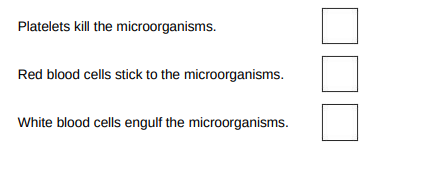
How does the immune system destroy microorganisms?(1)
White blood cells engulf the microorganisms

Vaccinations prevent people becoming ill with diseases such as measles. Complete the sentences. Choose answers from the box.
In a vaccine the measles virus is _______________. If the measles virus enters the body after vaccination the immune system reaction will be _______________.
(2)
weakened, fast
How is the measles virus spread from one person to another?(1)
by coughs

What was the range for the days on which children first showed chickenpox spots?(1)
10 to 18

Incubation time is the usual time from exposure to a pathogen until the first symptoms appear. Suggest the most likely incubation time for chickenpox. (1)
14 days
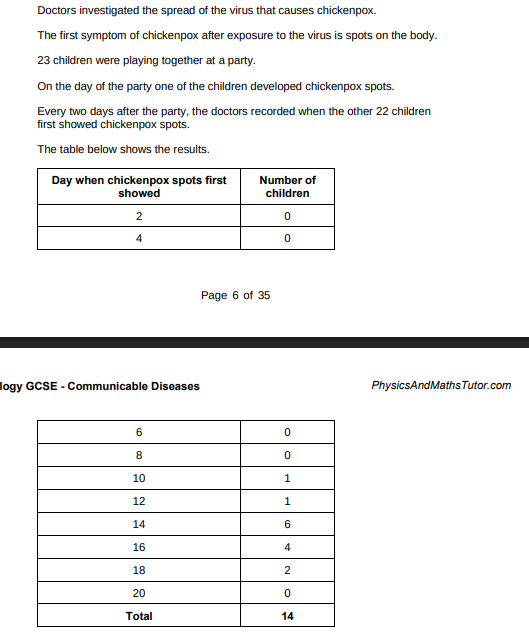
Suggest one reason why some of the children did not develop chickenpox.(1)
They were immune
One mother gave antibiotics to her child who had chickenpox. Suggest why this child did not recover more quickly than the other children who had chickenpox.(1)
Antibiotics do not kill viruses
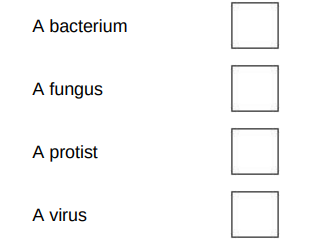
What type of pathogen causes malaria?(1)
Protist

Give one piece of evidence that supports the statement.(1)
Lower percentage of people with malaria when using mosquito nets
Suggest one reason why the statement may not be valid.(1)
Some people who use mosquito nets have malaria
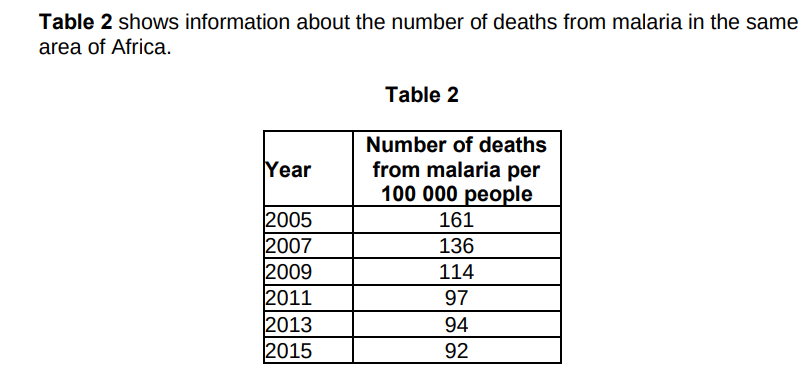
Predict the number of people per 100 000 who died from malaria in 2017 if the trend stayed the same.(1)
89
Use of mosquito nets has helped to reduce the number of deaths from malaria each year. Suggest one other reason for the reduced number of deaths from malaria each year.(1)
Improved health care
Describe how the human body:
• prevents pathogens from entering
• defends itself against pathogens inside the body.
(6)
Skin acts as a barrier with oil on surface of skin to repel pathogens. Scabs formed by platelets are also a barrier. Stomach contains hydrochloric acid that kills bacteria as well as the enzymes in the tears produced by eyes. Inside the body white blood cells engulf pathogens and produce antibodies to help destroy pathogens and antitoxins to neutralise poisons.
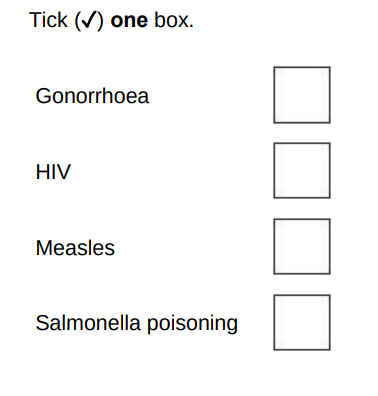
A man has the following symptoms:
• yellow discharge from his penis
• pain when urinating.
The man has a bacterial infection. What is the most likely cause of the man’s symptoms?
Gonorrhoea

The man took a full course of antibiotics. The man’s symptoms did not improve. Why did the antibiotics not cure the symptoms?(1)
The bacteria are resistant to the antibiotics
Using a condom can stop the bacteria being passed to another person during sexual intercourse. Suggest a different way the man could avoid passing the bacteria on to someone else.(1)
Abstain from sexual intercourse
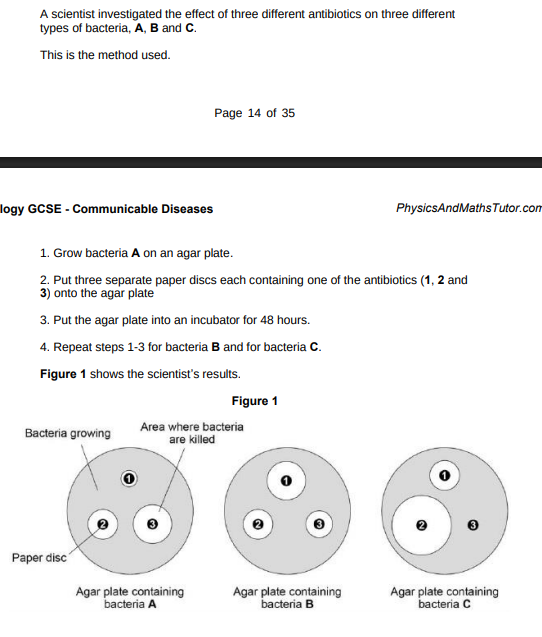
Compare the effectiveness of the three antibiotics at killing the different types of bacteria.(6)
On A 3 works best and 1 is least effective, on B 1 works best and 3 is least effective and on C, 2 works best 3 is least effective. 2 kills the same amount of A and B while killing more of C than A and B. 3 kills more of A and B than C because C are are resistant to 3

Which milk sample is shown in Figure 2?(1)
Sample E
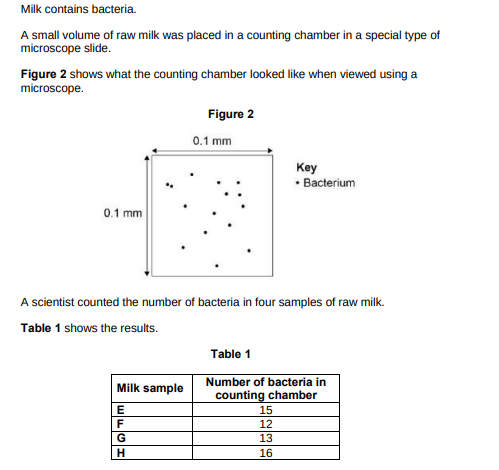
Calculate the mean number of bacteria in the four samples in Table 1.(2)
15 + 12 + 13 + 16/4 = 14
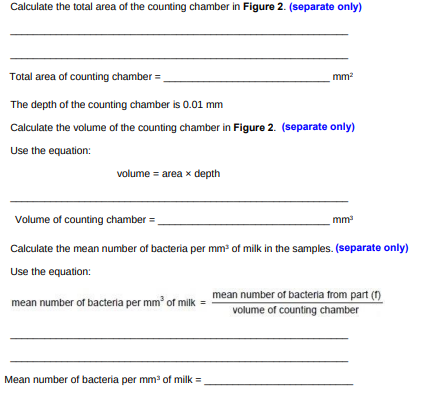
Calculate the mean number of bacteria per mm3 of milk in the samples. Complete the following steps (Length of one side: 0.1mm, mean number of bacteria: 14). (3)
0.1×0.1 = 0.01, 0.01×0.01 = 0.0001, 14/0.0001 = 140,000
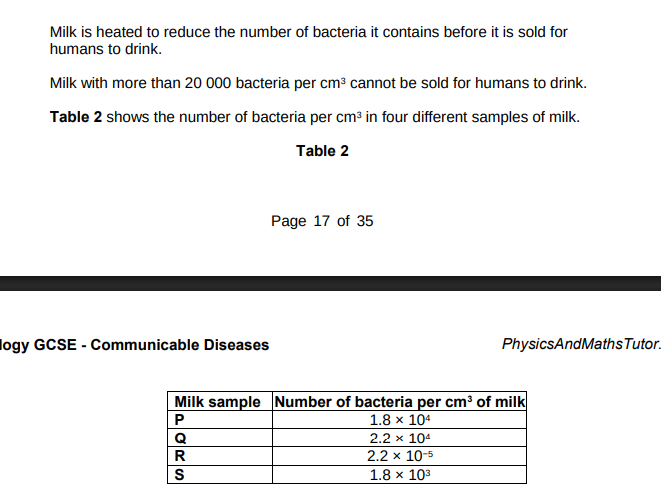
Which of the milk samples could not be sold for humans to drink?(1)
Q
Why should milk sold for humans to drink not contain large numbers of bacteria?(1)
Bacteria could make humans ill
Two symptoms of infection by Salmonella are vomiting and diarrhoea. What causes these symptoms?(1)
Toxins
Give two ways a person with a mild infection of Salmonella can help prevent the spread of the bacteria to other people.(2)
Isolate yourself, disinfect clothes
In very serious infections of Salmonella, a doctor can prescribe drugs to kill the bacteria. What type of drug can the doctor prescribe to kill the bacteria?(1)
Antibiotics
A person with AIDS may take longer than a healthy person to recover from a Salmonella infection. Explain why.(2)
Immune system is damaged so white blood cells cannot kill bacteria.
Salmonella bacteria can be transmitted from chickens to humans. Chickens can be vaccinated to prevent the transmission of Salmonella bacteria to humans. Suggest one other way farmers could prevent the transmission of Salmonella from chickens to humans.(1)
Keep infected chickens isolated

Which cleaning liquid is the more effective? Give a reason for your answer.(1)
B because greater reduction in number of bacteria in both locations
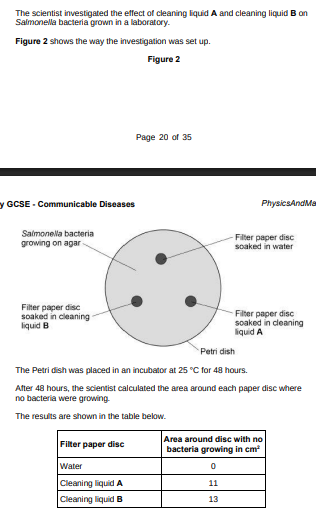
What measurement would the scientist need to take to calculate the area where no bacteria were growing?(1)
Radius
Give one change to the investigation that would allow the scientist to check if the results are repeatable.(1)
Repeat and look to see if results are similar
The scientist showed the results to the restaurant owner. Both cleaning liquids cost the same per dm3 . Suggest one other factor the restaurant owner should consider when choosing which cleaning liquid to use.
Side effects
Which type of pathogen can be killed by antibiotics?(1)
Bacteria

Draw one line from each drug to the organism it was originally extracted from.(2)
Aspirin: willow tree, Digitalis: Foxglove
New drugs must be tested before they can be used. Give one reason why drugs should be tested.(1)
To check they are safe

Doctors have developed a new drug. The new drug has been tested on live animals. What is the next stage in testing the new drug?
Testing on healthy volunteers
Vaccination can be used to prevent an illness in a person. Explain how a vaccination can prevent an illness.(4)
Dead pathogens are introduced into the body. White blood cells respond by producing antibodies specific to pathogen so antibodies can be produced quicker in larger quantities killing the pathogen later if the person is infected again.
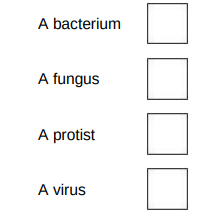
What type of microorganism causes rose black spot?(1)
A fungus
Explain how different types of organism defend themselves against microorganisms. (6)
Animals have skin which acts as a barrier along with oils on the surface that kills microbes. They have a stomach with hydrochloric acid to kill bacteria. They also have white blood cells that engulf microbes and produce antibodies and antoxins. Plants have a cell wall and waxy cuticle that is difficult to penetrate and they produce antibacterial chemicals to kill bacteria. Fungi also produce antibiotics that can kill bacteria.

Steps 1−5 could cause the sample of the bacteria on the petri dish to be contaminated. Give three improvements to the method to prevent contamination.(3)
Disinfect bench, Pass innoculating loop through flame, secure lid with tape
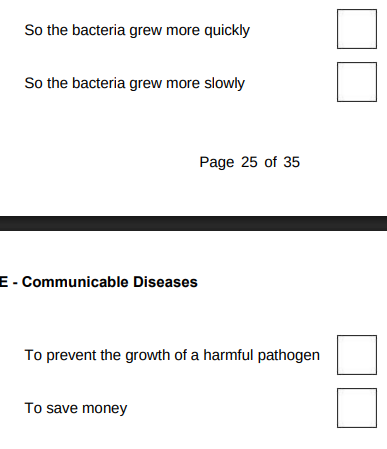
Why did the student grow the bacteria at 25 °C rather than at 40 °C?(1)
To prevent the growth of a harmful pathogen
A virus called RSV causes severe respiratory disease. Suggest two precautions that a person with RSV could take to reduce the spread of the virus to other people.(1)
Isolate patient from others, regular hand washing
One treatment for RSV uses monoclonal antibodies which can be injected into the patient. Scientists can produce monoclonal antibodies using mice. The first step is to inject the virus into a mouse. Describe the remaining steps in the procedure to produce monoclonal antibodies.(3)
Combine lymphosite with tumour cell and clone the hybridoma cell. Hybridoma divides rapidly and produces the antibody.
Describe how injecting a monoclonal antibody for RSV helps to treat a patient suffering with the disease.(2)
Monoclonal antibody binds to the virus so phagocytes kill the virus.
A trial was carried out to assess the effectiveness of using monoclonal antibodies to treat patients with RSV. Some patients were given a placebo. Why were some patients given a placebo?(1)
As a control
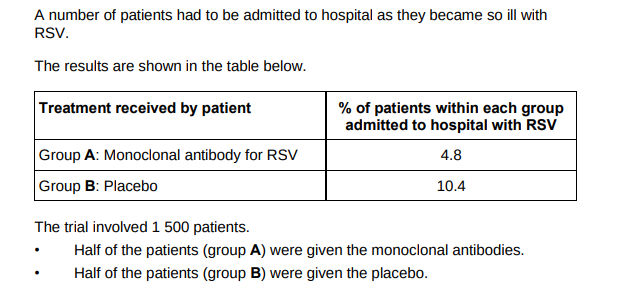
Calculate the total number of patients admitted to hospital with RSV during the trial.(2)
(4.8/100 × 750) + (10.4/100 × 750) = 114
Evaluate how well the data in the table above supports the conclusion: ‘monoclonal antibodies are more effective at treating RSV than a placebo’.(2)
Supports conclusion because over double the number of patients hospitalised with the placebo. Does not support conclusion because there is no information on patients that are not hospitalised.
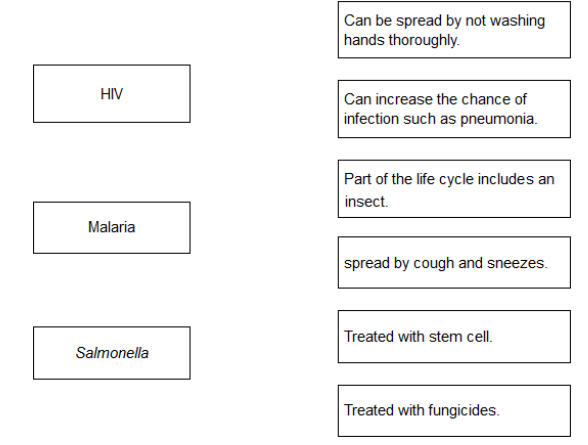
Draw one line from each disease to the correct description.(3)
HIV: Can increase the chance of infection such as phneumonia, Malaria: Part of the life cycle includes an insect, Salmonella: Can be spread by not washing hands thoroughly
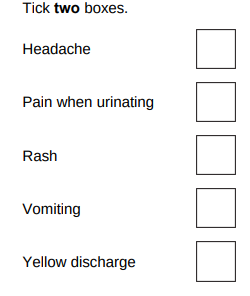
Gonorrhoea is a sexually transmitted disease. A bacterium causes gonorrhoea. What are the symptoms of gonorrhoea?(2)
Pain when urinating, yellow discharge
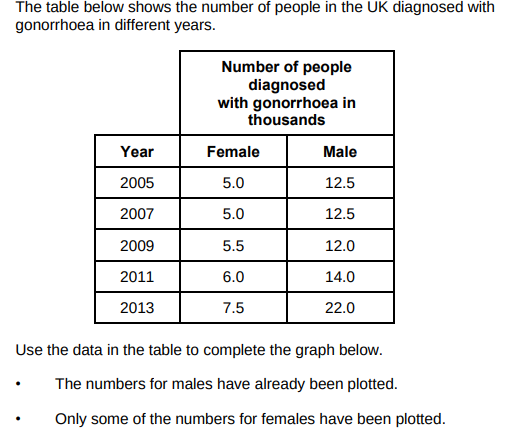
Describe the patterns in the numbers of males and females with gonorrhoea from 2005 to 2013.
Males are rising faster than females and they are always higher than females. There is a rise after 2009.
Gonorrhoea is treated with an antibiotic. HIV is another sexually transmitted disease. Explain why prescribing an antibiotic will not cure HIV.(2)
HIV is a virus and antibiotics do not kill viruses
Microorganisms cause infections. The human body has many ways of defending itself against microorganisms. Describe two ways the body prevents the entry of microorganisms.(2)
Skin forms a barrier, hydrochloric acid in stomach kills pathogens in food
In 2014 the Ebola virus killed almost 8000 people in Africa. Drug companies have developed a new drug to treat Ebola. Explain what testing must be done before this new drug can be used to treat people.(6)
Pre-clinical trials must be done on animals to test for efficacy, dosage and toxicity. After this, clinical trials are carried out on healthy volunteers and ebola patients at very low doses to test to monitor safety and side-effects. And then final trials are to test for efficacy and optimum dosage. The double blind trial is carried out involving a placebo which looks like the drug but does not contain it. The patients are randomly allocated into groups so that no one knows who has the placebo and the actual drug.

What type of organism is represented by the snail in the lifecycle of the lungworm?
vector
Suggest how the spread of the lungworm disease can be prevented.(3)
Isolate and treat infected dogs while destroying the snails.
Malaria is a disease spread by mosquitoes. Describe two ways to control the spread of malaria.(2)
Use mosquiteo nets, stop mosquitos from breeding
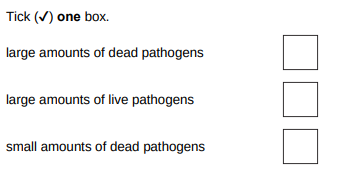
What is in a vaccine?(1)
Small amounts of dead pathogens
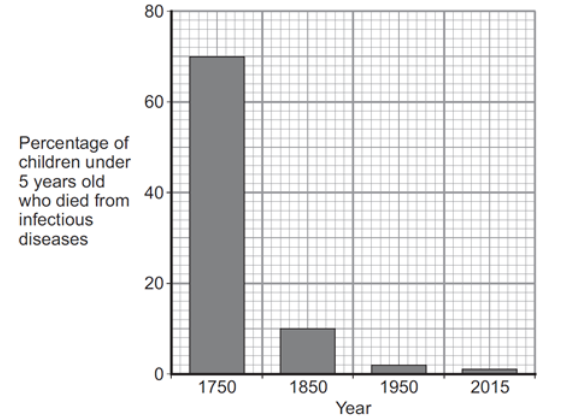
The advances in medicine had an effect on death rate. Describe the effect these advances had between 1750 and 1850. To gain full marks you should include data from the graph above.(2)
Decrease from 70 to 10 per cent

Antibiotics were developed in the 1940s. Antibiotics kill bacteria. Which one of the following is an antibiotic?(1)
penicillin
The use of antibiotics has not reduced the death rate due to all diseases to zero. Suggest two reasons why.(2)
Antibiotics only kill bacteria, some bacteria are resistant
In school laboratories, bacteria should be grown at a maximum temperature of 25 °C. Give one reason why companies testing new antibiotics grow bacteria at 37 °C.(1)
Bacteria grow faster